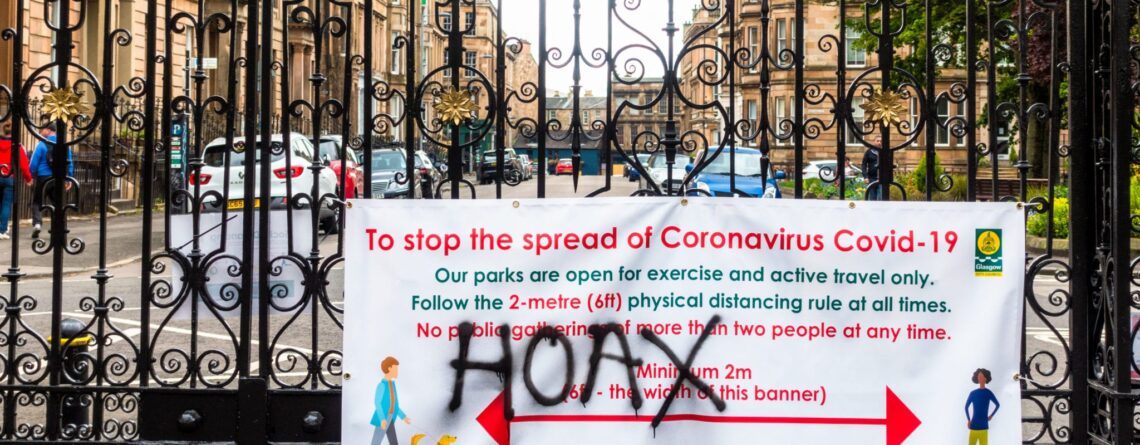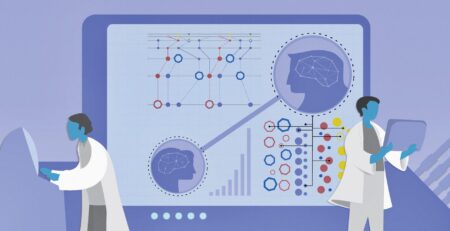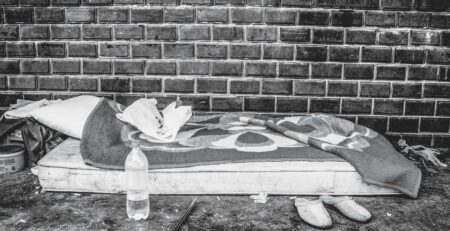This is custom heading element
[post-fields post_field=”wpcf-subtitle”]
[post-fields post_field=”wpcf-byline”]

Slowing the spread of COVID-19, a disease that has so far killed more than 250,000 Americans, requires mass-scale shifts in behavior. Persuading the public to stay home, practice social distancing, wear a mask or eventually get a vaccine is largely reliant on effective communications, says Holley Wilkin, associate professor of communication at Georgia State.
“First, you have to convince people that the virus is a threat that needs to be taken seriously,” says Wilkin. “Then you have to convince them that these changes will work to protect themselves and other people in their family or community.”
That has proven difficult, at least in America, where conspiracy theories about COVID-19 abound and public response to the pandemic has become deeply polarized among partisan lines. We recently spoke with Wilkin about what the events of 2020 have revealed about the importance of health education and communication.
According to some critics, public health messaging has failed during the pandemic. Why is it so difficult to communicate effectively during a health crisis?
One of the most difficult things is raise the right amount of fear in people. You want them to take the pandemic seriously, but you don’t want to go overboard so they think “please, that will never happen.” Then there’s the fact that if crisis-related communication is done properly, bad stuff doesn’t happen. That makes it easy to lose people’s confidence. People think you raised this big alarm for no reason.
With the current pandemic, we’re also trying to communicate to a massive audience — essentially every American. And yet there’s no monolithic audience out there that will respond to the same messages in the same ways. You need to frame the message differently for different groups of people, but you’ve also got to be consistent with the facts and the outcomes that you want to achieve. Laypeople typically don’t have a nuanced understanding of public health, and studies have shown that people in general are also not good at assessing personal risk. So, when you introduce an unfamiliar term like “social distancing,” for example, you need to define it and explain it and make it clear why it’s important.
Surveys show that large numbers of Americans today distrust the media and some politicians have pushed to discredit media outlets. How does that affect health communications efforts?
It certainly makes things more challenging as we’re looking around for trusted sources of information. We need to use multiple sources through multiple channels because a segment of people may not trust this person, but they might trust that person. It might be that people trust the members of an online group more than they trust their doctors.
In some cases, in an effort to appear fair and balanced, the media have inadvertently furthered misinformation. If a media outlet gives equal voice and time to science experts and science skeptics, whether it’s with regards to climate change or COVID-19, it conveys the message that “this is a debatable thing,” even when it’s not. People start to question whether scientists know what they’re talking about. The discrediting of the media along with the politicization of the pandemic and anti-science sentiment have really driven the poor pandemic response in the U.S.
What can we learn from looking at different countries and their responses to the pandemic?
One thing we learn with regards to health communication is there are major differences in how people receive messages based on their social norms. For example, several Asian countries had previously adopted the use of face masks to reduce the spread of disease, making it a lot easier to convince people from these countries to use masks during the pandemic than in countries where there were no established norms related to mask use.
Closer to home, if you compare the U.S. response and the Canadian response, you can see that Canada has done a much better job controlling the pandemic. Canada has some of the same culture of individual freedoms as the U.S., but one difference seems to be they’ve had consistent messaging from politicians, no matter what side of the aisle they’re on. It shows you need reinforcement of health messages through all levels of society and government.
The Centers for Disease Control and Prevention (CDC) has been criticized for its inconsistent and unclear messaging during the pandemic, particularly with regards to face masks. What went wrong there?
It goes back to the fact that we did not prepare, knowing that the pandemic was coming, the way we should have as a country. It’s likely that the shortage of personal protective equipment for hospitals and medical professionals was a driving force behind the CDC not explicitly saying “wear a mask” early on. They didn’t want everyone going out and buying up all the N95 masks when hospitals didn’t have enough. And if you’re staying home and not coming into contact with others, then you don’t really need them.
However, if that was the driving force, then instead of saying “no, masks don’t help,” they could have said, “it’s possible masks could help, but we know that our first responders need those masks. If you’re able to stay home, then you don’t need a mask right now.” Even a push to make cloth masks, for example, could have happened earlier had they not taken that hard line. It damaged the message to wear masks when the time came that the science supported widespread use of them to prevent the spread of the disease.
This is a new virus, and we’re learning more about it every day. Knowledge and information about how to prevent the spread of any disease will change the more you learn about it. It’s so important to be transparent about that and then explain why things change when they do.
The number of Americans who say they plan to get vaccinated against COVID-19 as soon as it’s available is falling. Are you concerned about how poor messaging could affect vaccine uptake?
As new surveys keep coming out, the percentage of people who say they’ll take a vaccine keeps going down. That’s concerning. How do we get the message across when you have a large segment of the population that still believes COVID-19 is no big deal or it’s a hoax? Not everybody gets the flu shot every year, and many people believe this virus is no worse than the flu.
Moving forward with communication around the vaccines, there are two critical questions to consider. One, how do we get people to understand the science that went into developing these vaccines so the public feels that it’s safe? And two, how do we get people to understand the risk-to-benefit ratio of the vaccine? Weighing the unknown risk of a new vaccine compared to the unknown risk — or perceived risk — of getting COVID-19 is challenging. Like mask wearing, getting vaccinated is also something that you’re doing to protect other people as well as yourself, and we’ve learned that getting people to take action for the public good is challenging at this time.
Surveys show that Black Americans are more skeptical of getting vaccinated than their white counterparts. What can experts do to help reduce vaccine hesitancy in this population?
Black communities are disproportionately impacted by COVID-19 and also historically skeptical of the medical community, for good reason. Even during the COVID-19 vaccine trials, anecdotally we heard it was challenging for drug makers to get a diverse set of clinical trial subjects. As a result, there needs to be a lot of thought put into the right messages and sources of information.
I think we need to enlist community leaders to advocate for the vaccines when they become available because they’re going to be more trusted than a lot of other sources. We also need to consider whether it’s better to frame the vaccine message in terms of what you have to gain rather than what you might lose.
Research suggests that when you’re in a community that’s profoundly affected by health disparities, as Black Americans are, loss framing doesn’t always work well. For example, if someone says you could die of lung cancer if you don’t quit smoking, but you’re also told that you might die of 10 other things, the message gets diluted. For Black communities, gain framing may work better — emphasizing what you have to gain by getting the vaccine rather than what you could lose if you don’t get it. I’m sure we will see more research in this area with regard to vaccine adoption over the next year.
We’ve talked a lot about the importance of good health communication, but is there also a limit to what it can accomplish?
One of the limitations has to do with the fact that there are multiple levels of influence on health behaviors. We often approach health behaviors as if they are 100 percent within an individual’s control and as a society even blame people for health problems that may not have been in their control (for example, obesity, diabetes, heart disease). Our own behaviors and attitudes are important, but there are also factors at the organizational, community and policy levels that impact health outcomes as well. The pandemic has highlighted the ways in which we are interdependent.
That’s why much of my research focuses on the neighborhood level. What good is a message that tells people to eat healthy or to exercise if they live in a neighborhood with no healthy food options or safe places to work out? Or if work conditions mean that they do not have the time to do either? I try to understand the unique challenges that people face in their everyday lives — whether it’s having a primary healthcare home, eating healthy foods, or socially distancing and wearing a mask during a pandemic — so that we can collectively find and promote solutions for overcoming those barriers.












Leave a Reply